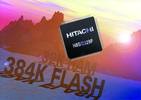16 bit micros first with 32 KB on-chip RAM
28 March 2001
DSP, Micros & Memory

Hitachi Europe has available a new series of 16 bit microcontrollers featuring 32 KB on-chip RAM - the first in the industry to do so. The series includes two ROM-less devices and one 384 KB Flash derivative, each combined with 32 KB fast SRAM. The devices are part of Hitachi's H8S microcontroller family, offering high 16 bit performance and significant on-chip memory and peripheral resources.
The series comprises of the H8S/2329F with 384 KB on-chip Flash (3,3 V/25 MHz), the ROM-less H8S/2324 (3,3 V/25 MHz) and the ROM-less H8S/2394 (5 V/20 MHz). At 25 MHz these devices offer approximately 12 MIPS Dhrystone, if executing from on-chip memory. The new chips are almost pin-compatible with the existing H8S/2357F, H8S/2350 and 2532 devices, all popular ROM-less and Flash devices.
Each device in the series offers the same peripheral set. This includes a DMA controller with four channels and a data transfer controller (DTC), which is a popular and more flexible versatile pseudo DMA. A bus state controller (BSC) divides the 16 MB memory space into eight areas. A number of parameters can be programmed into each of these to allow glueless access to numerous external memories and peripherals.
The H8S/2394 is supported by Hitachi's EVB2357F evaluation board for evaluation purposes and by the E6000 emulator-kit S6P-2655, which comes with everything needed, including a C Compiler. The H8S/2324 and H8S/2329F are supported by Hitachi's new E6000 emulator kit S6-2339 and by Lauterbach's Trace32-FIRE.
[email protected]
Further reading:
Memory for asset tracking
Altron Arrow
DSP, Micros & Memory
The Page EEPROM, ST’s latest memory, has been designed for efficient datalogging and fast firmware upload/download in battery-operated devices.
Read more...
Engineered for high-reliability applications
Future Electronics
DSP, Micros & Memory
The MCX E series of Arm Cortex-M4F and Arm Cortex-M7 microcontrollers from NXP are engineered for demanding industrial and IoT environments.
Read more...
NXP’s development platform guide
DSP, Micros & Memory
Choosing between the FRDM i.MX 93, FRDM i.MX 91 and FRDM i.MX 91S development platforms can be intimidating, but once designers understand how each platform aligns with their application’s requirements, the decision becomes straightforward.
Read more...
XJTAG launches two new Flash programmers
ASIC Design Services
DSP, Micros & Memory
XJTAG has announced XJExpress and XJExpress-FPGA, a pair of Flash programmers perfect for development, debug and in-service applications.
Read more...
Processor offers competitive solution for advanced HMIs
Future Electronics
DSP, Micros & Memory
The new RZ/A3M microprocessor from Renesas features 128 Mbytes of fast DDR3L DRAM memory for system cost reduction, and supports
1280 x 800 px video resolution at a rate of 30 frames/s.
Read more...
ESP32-C6 achieves PSA-L2
iCorp Technologies
DSP, Micros & Memory
Espressif Systems recently announced that its ESP32-C6 microcontroller has achieved PSA Certified Level 2 (PSA-L2) security certification, making it the first RISC-V-based MCU to reach this level.
Read more...
Microprocessor with integrated NPU
Avnet Silica
DSP, Micros & Memory
The RZ/G3E from Renesas is a microprocessor integrated with quad CPU and NPU in one chip, improving power efficiency, reliability, and security.
Read more...
Nordic Semiconductor launches nRF Connect SDK Bare Metal option for nRF54L series
Avnet Silica
DSP, Micros & Memory
This is a new, RTOS-independent software solution for Bluetooth LE development, designed to ease developers’ migration from the legacy nRF5 SDK and nRF52 series to the next-generation nRF54L series.
Read more...
Dual-core support in NECTO Studio
DSP, Micros & Memory
MIKROE recently announced that version 7.3.0 of its NECTO Studio Integrated Development Environment now supports dual-core MCUs, allowing designers to program and debug each core independently.
Read more...
Post Quantum Cryptographic firmware library
DSP, Micros & Memory
The STM32 post-quantum cryptographic library enables developers to satisfy application requirements for any combination of data integrity, confidentiality, identification/authentication, and nonrepudiation.
Read more...


